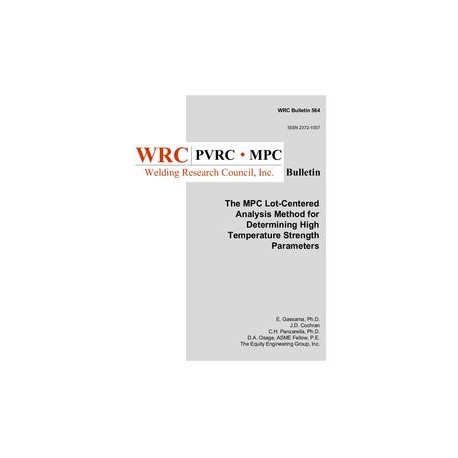Cart
0
Product
Products
(empty)
No products
To be determined
Shipping
$0.00
Total
Product successfully added to your shopping cart
Quantity
Total
There are 0 items in your cart.
There is 1 item in your cart.
Total products
Total shipping
To be determined
Total
Reduced price!
 View larger
View larger
 View larger
View larger
WRC 564
M00000024
New product
WRC 564 The MPC Lot-Centered Analysis Method for Determining High Temperature Strength Parameters
Bulletin / Circular by Welding Research Council, 2020
E. Gassama, Ph.D., J.D. Cochran, C.H. Panzarella, Ph.D., D.A. Osage, ASME Fellow, P.E.
In stock
More info
Full Description
The analysis of creep-rupture data for the purpose of interpolation and extrapolation is explained for multi-heat material data. Lot-centering is an efficient method of analyzing multi-heat data, capturing the average behavior with a single curve as well as the individual heat behavior with heat specific curves. In this bulletin, an explanation of the lot-centering technique is presented for creep rupture data using four of the most common time-temperature parameter models: Larson-Miller, Manson-Haferd, Manson-Succop and Orr-Sherby-Dorn models. The heat-to-heat variations in the data are accounted for in the master curve through the Mandel-Paule algorithm which estimates the consensus mean for multi-heat data. The technique is demonstrated through the Armco Steel Corporation Nitronic-50 alloy data reported in MPC-23 [1] and the normalized and tempered 2.25Cr-1Mo stress-rupture data reported in Booker et al. [3].The polynomial form of the time-temperature parameter models can sometimes be problematic when extrapolating outside the bounds of the data, if constraints are not imposed on the model coefficients to prevent non-physical behavior. In this report, a methodology that enforces physical behavior of the time temperature curves at very low and high stresses is also demonstrated.
Creep tests at low stress can be influenced by the effects of oxidation due to the long test times required, especially when testing small diameter specimens. This oxidation effect influences the calculated master curve developed from the test data. A methodology suggested by Nikashiro et al. [26] is implemented to correct the calculated master curve for the effects of oxidation. Rate equations for the oxidation scale thickness are used to determine the true stress variation. The true stress variation is coupled with a linear damage rule to estimate the true creep rupture time. This correction methodology for oxidation effects is illustrated with two sets of data: The National Research Institute for Metals (NRIM) creep data for 2.25Cr-1Mo, and ASTM creep data. The results show that the NRIM data, which is from smaller diameter test specimens at lower stresses, demonstrate the largest oxidation effects. The high stress and large specimen diameter test data from ASTM show very little oxidation effects, as expected.

